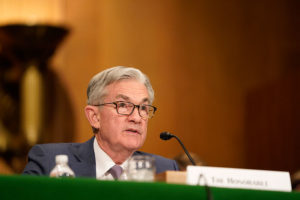
Chair Powell presents the Monetary Policy Report to the Senate Committee on Banking, Housing, and Urban Affairs, February 12, 2020.
The Federal Reserve has been operating an emergency monetary policy filled with new programs, some of which operate on the fringes of its statutory limitations. Bloomberg’s Christopher Condon reports on when the Fed might consider pulling back on some of these stimulus programs. He writes:
Jerome Powell isn’t “even thinking about thinking about” raising interest rates, but investors still wonder what it would take for the Federal Reserve chair to start taking his foot off the gas.
U.S. central bankers dropped some strong hints on the answer to that question this past week.
The minutes of the Federal Open Market Committee’s June 9-10 meeting, released July 1, showed “a number” of policy makers favor tying future moves for interest rates and asset purchases to inflation. They even suggested they’ll wait until inflation overshoots the Fed’s 2% target before making substantial changes.
That surprised some Fed watchers, but perhaps it shouldn’t have.
Just before the COVID-19 pandemic hit, officials were heading into the home stretch of an extended policy framework review that was already pointing to a major shift in the way the Fed interprets its price-stability mandate.
Chided for long overestimating where they forecast inflation would go — only to see it fall repeatedly short — several FOMC members had resolved to push it at least modestly above target.
That the lessons from the framework review — rooted deeply in fundamental ideas about how the economy has changed over decades — would merge into the FOMC’s month-to-month decision making was probably inevitable. But it was uncertain when and how that might happen.
The recent minutes make clear these two rivers are poised to flow together in coming months as officials lay out guidelines for future policy.
Read more here.
